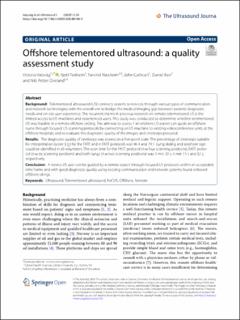| dc.contributor.author | Vatsvåg, Victoria | |
| dc.contributor.author | Todnem, Kjetil | |
| dc.contributor.author | Næsheim, Torvind | |
| dc.contributor.author | Cathcart, John | |
| dc.contributor.author | Kerr, Daniel | |
| dc.contributor.author | Oveland, Nils Petter | |
| dc.date.accessioned | 2020-07-24T08:22:52Z | |
| dc.date.available | 2020-07-24T08:22:52Z | |
| dc.date.created | 2020-07-21T13:07:08Z | |
| dc.date.issued | 2020-07 | |
| dc.identifier.citation | Vatsvåg, V., Todnem, K., Næsheim, T. et al. (2020) Offshore telementored ultrasound: a quality assessment study. Ultrasound Journal, 12:33, pp. 1-12. | en_US |
| dc.identifier.uri | https://hdl.handle.net/11250/2670106 | |
| dc.description.abstract | Background
Telementored ultrasound (US) connects experts to novices through various types of communication and network technologies with the overall aim to bridge the medical imaging gap between patients’ diagnostic needs and on-site user experience. The recurrent theme in previous research on remote telementored US is the limited access to US machines and experienced users. This study was conducted to determine whether telementored US was feasible in a remote offshore setting. The aim was to assess if an onshore US expert can guide an offshore nurse through focused US scanning protocols by connecting an US machine to existing videoconference units at the offshore hospitals and to evaluate the diagnostic quality of the images and cineloops procured.
Results
The diagnostic quality of cineloops was scored on a five-point scale. The percentage of cineloops suitable for interpretation (score 3 ≥) for the FATE and e-FAST protocols was 96.4 and 79.1. Lung sliding and seashore sign could be identified in all volunteers. The scan time for the FAST protocol (n = four scanning positions), FATE protocol (n = six scanning positions) and both lungs (n = two scanning positions) was 1 min 20 s, 4 min 15 s and 32 s, respectively.
Conclusion
A novice US user can be guided by a remote expert through focused US protocols within an acceptable time frame and with good diagnostic quality using existing communication and network systems found onboard offshore oil rigs. | en_US |
| dc.language.iso | eng | en_US |
| dc.publisher | Springer International Publishing | en_US |
| dc.rights | Navngivelse 4.0 Internasjonal | * |
| dc.rights.uri | http://creativecommons.org/licenses/by/4.0/deed.no | * |
| dc.subject | ultralyd | en_US |
| dc.subject | diagnostisering | en_US |
| dc.title | Offshore telementored ultrasound: a quality assessment study | en_US |
| dc.type | Peer reviewed | en_US |
| dc.type | Journal article | en_US |
| dc.description.version | publishedVersion | en_US |
| dc.rights.holder | © The Author(s) 2020 | en_US |
| dc.subject.nsi | VDP::Medisinske Fag: 700 | en_US |
| dc.source.pagenumber | 1-12 | en_US |
| dc.source.volume | 12 | en_US |
| dc.source.journal | Ultrasound Journal | en_US |
| dc.identifier.doi | 10.1186/s13089-020-00180-9 | |
| dc.identifier.cristin | 1820034 | |
| cristin.ispublished | true | |
| cristin.fulltext | original | |
| cristin.qualitycode | 1 | |

